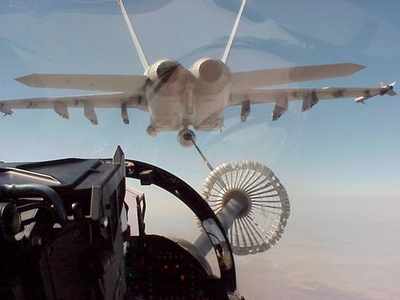Wed, Jul 08, 2009
System Designed For Aerial Refueling Applications
 GE Aviation successfully completed initial flight testing of
its Electro-Optical Grid Reference System (EOGRS) for aerial
refueling applications in late June. This activity demonstrates
that GE’s grid navigation system is on target to support
automatic aerial refueling of both manned and unmanned aircraft
using either probe and drogue or boom and receptacle
techniques.
GE Aviation successfully completed initial flight testing of
its Electro-Optical Grid Reference System (EOGRS) for aerial
refueling applications in late June. This activity demonstrates
that GE’s grid navigation system is on target to support
automatic aerial refueling of both manned and unmanned aircraft
using either probe and drogue or boom and receptacle
techniques.
"These flight tests validate our technology for refueling drogue
stabilization as well as positioning of aircraft in the vicinity of
the tanker,” said Lorraine Bolsinger, president and CEO of GE
Aviation Systems. “This marks the first use of GE proprietary
laser grid technology and positions us to continue to advance
state-of-the-art aerial refueling technology.”
A series of flights were conducted using an Omega Aerial
Refueling Services Inc K-707 tanker with centerline hose and drogue
aerial refueling systems. The K-707 was modified by adding
GE’s EOGRS transmitter and a form, fit, and function
replacement US/NATO standard MA-3 refueling drogue with EOGRS
detectors. The modification also included a “truth
data” package that generated independent navigation
information to allow the reference system performance to be
quantified and validated.

File Photo
EOGRS uses an eye-safe laser scanning system that is
night-vision-goggle compatible to project an invisible laser grid
behind the tanker. This grid also contains data that is decoded by
the EOGRS laser detectors (in this case mounted on the refueling
drogue) to form a measurement of 3-dimensional tanker-relative
position within the grid reference system. Spare bandwidth in the
transmission mechanism is used to form half of a bi-directional
data link between the transmitter and vehicles provisioned with
EOGRS detectors. These vehicles can include refueling drogues and
manned or unmanned receiver aircraft and facilitate automatic
aerial refueling without the need for human involvement.

File Photo
In addition to validating the navigation system, the testing
collected drogue motion data when the aircraft and refueling
equipment were subjected to atmospheric turbulence and aircraft
maneuvers, which included various pilot control inputs. The flight
tests were conducted across the speed and altitude envelope of the
tanker aircraft and all normal drogue extension, retraction and
stowage functions were exercised.
More News
How To Get A Story On Aero-TV News/Feature Programming How do I submit a story idea or lead to Aero-TV? If you would like to submit a story idea or lead, please contact Jim Campbel>[...]
Aero Linx: International Association of Professional Gyroplane Training (IAPGT) We are an Association of people who fly, build or regulate Gyroplanes, who have a dream of a single >[...]
NORDO (No Radio) Aircraft that cannot or do not communicate by radio when radio communication is required are referred to as “NORDO.”>[...]
Also: uAvionix AV-Link, F-16 Viper Demo, TN National Guard, 'Staff the Towers' A Saturday afternoon jump run, originating from SkyDive Kansas City, went bad when it was reported th>[...]
Beyond Visual Line Of Sight (BVLOS) The operation of a UAS beyond the visual capability of the flight crew members (i.e., remote pilot in command [RPIC], the person manipulating th>[...]
 ANN FAQ: Contributing To Aero-TV
ANN FAQ: Contributing To Aero-TV ANN's Daily Aero-Linx (05.29.24)
ANN's Daily Aero-Linx (05.29.24) ANN's Daily Aero-Term (05.29.24): NORDO (No Radio)
ANN's Daily Aero-Term (05.29.24): NORDO (No Radio) Airborne 05.28.24: Jump Plane Down, Starship's 4th, Vision Jet Problems
Airborne 05.28.24: Jump Plane Down, Starship's 4th, Vision Jet Problems ANN's Daily Aero-Term (05.30.24): Beyond Visual Line Of Sight (BVLOS)
ANN's Daily Aero-Term (05.30.24): Beyond Visual Line Of Sight (BVLOS)





